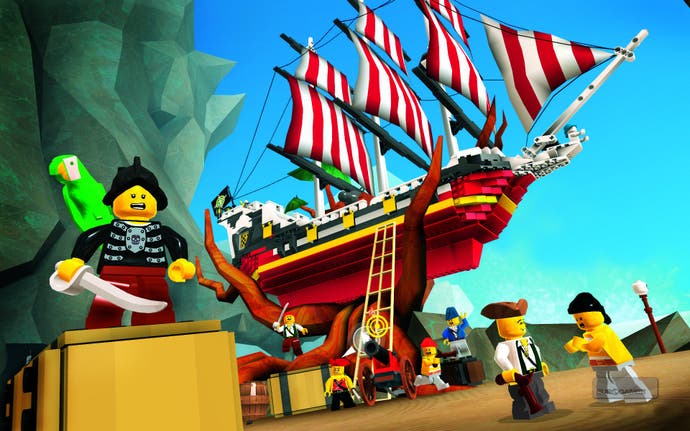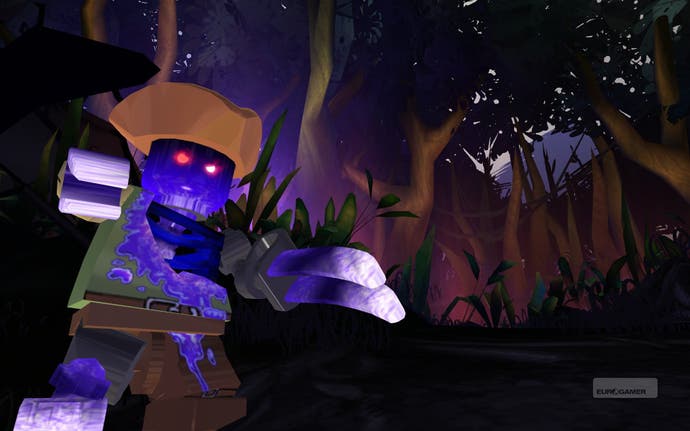LEGO Universe
New build.
Nobody could accuse NetDevil of being unambitious. Three-and-a-half years in development, LEGO Universe is an attempt to graft the framework of a full MMORPG onto a plastic chassis designed to appeal to kids.
While it's no secret that young 'uns love the social aspects of MMO games, and the breadcrumb trail of character creation and development, most successful online games pitched at this audience focus their attention on minigames and unlockable widgets. The likes of Club Penguin, Clone Wars Adventures and Moshi Monsters all favour 2D graphics and browser interfaces.
Disney's Toontown Online, by contrast, launched its polygon animation fantasia to much fanfare in 2002. It's quietly dropped off the radar in recent years, consolidating its undisclosed userbase onto US servers earlier this year. Pitched at an audience that clearly responds to simplicity, LEGO Universe's sprawling 3D World of Brickcraft is a risky undertaking.
Will it pay off? The closed beta stage of LEGO Universe recently came to an end, finally giving us our first hands-on impressions of what will await eager brick-builders who sign up for the full experience.
After creating your minifigure avatar from a small selection of available pieces, you're dropped into a space station emergency where you're introduced to two of the key gameplay elements – imagination and construction.
Imagination is the LEGO Universe equivalent of MP, the currency you expend every time you tackle one of the numerous Quick Builds littering the landscape. These are signified by piles of jiggling blocks, just as they are in the console LEGO titles. A little bubble informs you how much Imagination you'll need to put the bits together. If you have enough, holding down the Shift key constructs the object in a flurry of movement.

You can top up Imagination by smashing other items, or by consuming potions and food items available from in-game vendors. Since there's no character levelling in the game, your maximum Imagination is dictated by the items and clothing you equip.
Construction, meanwhile, comes in three flavours. Quick Build is the most basic, used to insert specific objects into the game, such as bridges or springboards to reach new mission-specific areas. The next step up involves putting together predefined blocks, as illustrated by the rocket you put together to escape from this first tutorial area.
You get a selection of rocket pieces – nose cones, cockpits, engines – and whatever combination you choose can then be saved as a completed model. Dragged and dropped from your inventory backpack onto a launchpad, it becomes your default mode of transport between the various worlds of LEGO Universe.
Having learned the basics and escaped from the space station, you enter the gameworld proper. It's here you start getting missions from NPCs, and meet your enemies – the Stromlings, corrupted minions of something called The Maelstrom, which threatens LEGO Universe with its black and purple tendrils of vague evil.
Combat is simple enough. Equip a weapon – a basic sword is your starter, but you can quickly purchase spears, guns and more impressive items – and then mash the Alt key to attack.
Firearms can be aimed with the mouse, while longer button presses charge up more powerful attacks. Defeated enemies and any smashed scenery items cough up more Imagination along with health and armour top-ups, and new LEGO bricks for your collection.

Missions are also simple, generally revolving around standard fetch quests for items or destroying a set number of enemies. The early stages available in the beta continue the tutorial theme, setting players the task of building their first house, taming a pet or designing a racing car.
That these tasks also showcase some of the extra-curricular activities available away from the war against the Stromlings is no accident. There's a lot to do, and even within a few hours of play you'll have put your stamp on the game.
Perhaps most intriguing is the ability to put objects together using individual LEGO bricks. These have to be sent off for moderation, just to minimise the number of giant plastic nobs, but are then imported back as a self-contained in-game object.
You can dictate whether other players will be able to smash your creation and even attach "behaviours" to your it, such as basic mobility and AI. So if you want your giant plastic nob to act as a guard dog for your LEGO house, that's a possibility.








